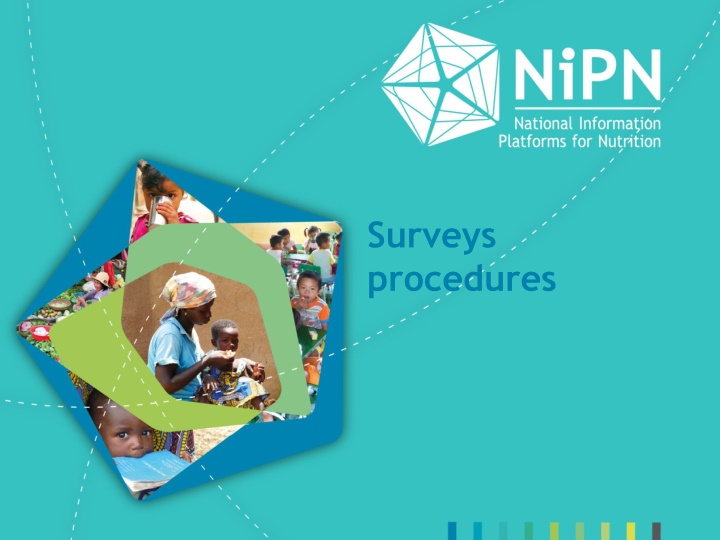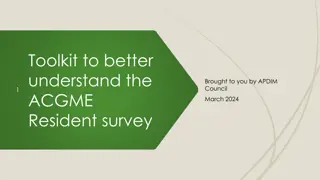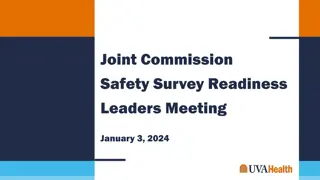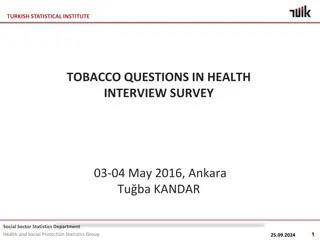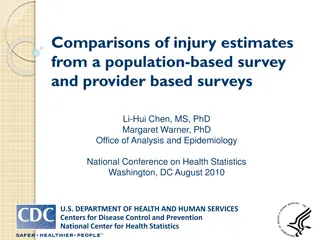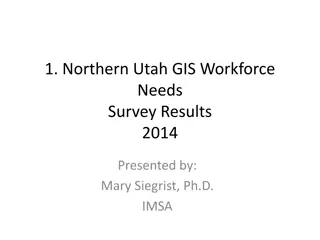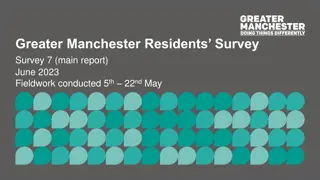Survey Procedures and Organization
In the realm of surveys, understanding the procedures involved in planning, sampling, and design is crucial. From minimizing errors to ensuring data quality, this content delves into the intricacies of survey implementation. Topics covered include survey objectives, organization, planning, sampling methods, and obtaining a representative sample through probability sampling. The content emphasizes the importance of expert involvement, ethical considerations, and adherence to established protocols to gather reliable data for informed decision-making.
Download Presentation

Please find below an Image/Link to download the presentation.
The content on the website is provided AS IS for your information and personal use only. It may not be sold, licensed, or shared on other websites without obtaining consent from the author.If you encounter any issues during the download, it is possible that the publisher has removed the file from their server.
You are allowed to download the files provided on this website for personal or commercial use, subject to the condition that they are used lawfully. All files are the property of their respective owners.
The content on the website is provided AS IS for your information and personal use only. It may not be sold, licensed, or shared on other websites without obtaining consent from the author.
E N D
Presentation Transcript
Surveys procedures
Surveys procedures Objectives Understand how a survey works and what to do to minimize errors Type of errors Factors to consider when looking at prevalence data Confidence intervals 2
Surveys procedures Organization and survey design Planning Sampling Questionnaire development Training and standardization Equipment 3
Surveys procedures Planning An expert on anthropometry should be a member of the survey steering committee Include information on children below 6 months of age Using computer-assisted data collection in the field Signing an agreement with government for public release of datasets Obtaining ethical approval The recruitment process should include a test 4
Surveys procedures Sampling Sample size is reported and available Sampling frame is available Train interviewers and other field staff to follow the sampling plan and survey methodology Develop the second-stage sampling frame for selected PSUs before each survey (don t use old lists) Clear household definition Household replacement 5
Surveys procedures How do we obtain a representative sample? 6
Nutrition surveys Probability sampling requires a randomness and is statistically representative, i.e. no one has control over the of individuals or households selection. 7
Sampling National SMART NNS DHS MICS SMART Cross-sectional household survey; 2-stage cluster sampling, cluster selection using PPS; HHs randomly pre- selected from HH listing; no replacement HHs Cross-sectional household survey; 2-stage cluster sampling, cluster selection using PPS; large clusters may be segmented; HHs randomly or systematically selected, HH lists used when available or may be developed; for emergency situations HHs selected in the field; protocol includes no replacement HHs Cross-sectional household survey with several strata (often 1 per province/region). HHs selection same as local SMART 8
Surveys procedures Questionnaires record is kept of all sampled households (whether interviews are completed or not) Translation in local languages Independent child questionnaire Local event calendar developed Questionnaire was tested Interviewers 'manual developed 9
Surveys procedures Training and standarization Training of enumerators conducted Standardization exercises conducted Enumerators practiced anthropometric measurements Pilot tests conducted 10
DHS MICS SMART 3 days plus field practice 2.5 days plus one week of field practice 3 6 days including theory and practical sessions Training on antrhopomet ry 3 5 months 2 3 months 1 2 months (< 2 weeks for smaller surveys) Supervisor (one for every 2 teams), team leader, two measurers (for anthropometry) Survey duration Supervisor, interviewers, 1 2 biomarker technicians, field editor Supervisor, interviewers, measurer (for anthropometry), field editor Team composition 11
Surveys procedures Equipment Digital weighing scales for children 0 to 5 years old Portable length/height measuring board for children 0 to 5 years old Reuse of anthropometric equipment is not recommended 12
Surveys procedures Field work procedures Data collection procedures Interview and measurements Data capture/entry Quality assurance methods and field supervision 13
Surveys procedures Data collection procedures Coordination with local authorities Non responses are documented Call backs are scheduled Verbal permission is sought from respondents 14
Surveys procedures Interview and measurements Clear explanation on how to: Collect the date of birth Placement of equipment Individuals with special needs Children wearing clothes Calibrate equipment Record measurments 15
Surveys procedures Data capture and entry Aproches paper forms for collecting data, with subsequent data entry in a central office paper forms for collecting data, with same-day data entry in the field computer-assisted data collection Many types of transcription errors 16
Surveys procedures Quality assurance methods during data collection Field supervision Re-measurement Central level checks 17
DHS MICS SMART Exact age in days based on year, month, and day of birth and visit date Age based on year, month, and day of birth, or if exact birth date unavailable, estimated year and month of birth based on a seasonal calendar Age determinati on Seca 878 digital scales; Shorr boards, or boards similar to the Shorr board Equipment Field-check tables Cluster control form and ENA software Field checks for data quality 18
Surveys procedures Check tables Similar to the check tables for supervisors you should build your own check tables to ensure that a survey has put all the measures in place to ensure data quality Go over this presentation later today and build your own check tables, it will become handy tomorrow 19
Surveys procedures Assessing a survey s data quality 1. Looking at the survey report and checking the methodology to ensure that they were minimizing the errors 2. Implementing statistical tests on the data 20
Surveys procedures Data quality controls Selection bias Is the sample representative? Measurement bias Are measurements accurate? 21
Factors to Consider Confidence Intervals (CI) Seasonality Aggravating factors or risks Baseline or normal prevalence Prevalence of other types of malnutrition e.g. MDDs, chronic malnutrition Mortality levels Disaggregation of subnational levels Weights of different region (for national surveys) 22
Surveys procedures Confidence intervals Surveys will determine by convention a 95% confidence interval: what does it mean? Assuming that the prevalence of GAM in the entire population is what you estimate in your survey, then if you repeat your survey 100 times with a different sample each time, 95 of these surveys would give a result inside the confidence interval. 23
Prevalence of Malnutrition: Sudanese refugee camps, Uganda (1998- 99) 24
Surveys procedures ALWAYS look at the confidence intervals 25
Exercise The results of the survey you just conducted are: GAM prevalence estimate = 6.3% (4.7% - 8.5% CI 95%). The last survey you conducted 6 months ago showed a GAM prevalence estimate of 10.6 % (8.8% - 12.9% CI 95%). Can you say that there is a significant difference between those two survey results? Explain why. 26
Exercise The baseline survey in your region showed a GAM prevalence estimate of 7.2% (5.3% - 9.5% CI 95%). You just finished a survey and you found a prevalence estimate of 8.1% (6.5% - 9.6% CI 95%). Can you say that the actual situation in terms of GAM prevalence is significantly different from the baseline? Explain your answer 27
Aggravating Factors General ration below 2,100kcal. CMR >1/10,000/day Epidemic (measles, whooping cough) High incidence of respiratory or diarrheal disease 28
Excercise Develop your on check table later on your own 29
